On August 16-17, 2022, meteoric activity of an unknown meteor shower was detected in Aquarius/Capricorn region by CAMS network in USA and Chile (Figure 1a to 1d). The coordinates of the radiant of the source calculated by Peter Jenniskens (CBET 5159, see below) from the trajectory of nearly 40 meteors (recorded from Aug.15, 20h 37min UT to Aug. 16, 12h 02min UT) is R.A. = 324.7 +/- 0.2° ; Decl. = -11.6 +/- 0.3° (equinox J2000.0) with a geocentric velocity of 24.2 +/- 0.3 km/s, when the solar longitude was 143.1°. This new meteor shower is temporarily designated under M2022-Q1 code, and should be called 18-Aquariids in the future. The shower was not detected by CMOR (Canadian Meteor Orbit Radar) system of the University of Western Ontario. This was probably due to the fact that “the outburst was apparently restricted to brighter meteors rather than sub-millimeter radar sizes”, explains Peter Brown.
A meteor shower outburst that could be associated to 45P/Honda-Mrkos-Pajdusakova
If comet disappeared comet D/1770 L1 (Lexell) is said to be a candidate, further calculations from comet specialists tend to show there are many other possibilities. Bill Cooke thus states that “the mean orbit of the new shower meteors can be matched to at least known 16 candidates – there are lots of potential parent bodies in that low inclination space.” Roberto Haver believes that it may be linked to a young dust trail ejected in 1980 from comet 45P/Honda-Mrkos-Pajdusakova which was predicted to be the source of a possible increase of activity, on Aug. 16, 23h 40min UT, from a radiant located at coordinates R.A. = 326.8° ; Decl. = -15.1° (equinox J2000.0) according to Mikhail Maslov calculations. V. Porubcan and M. Gavajdova mention in their paper on A Search for fireball Streams Among Photographic Meteors that a shower called the #199 August delta Capricornids (ADC) was found to be most active at solar longitude 146°, which corresponds to August 19th in 2022. An hypothesis confirmed with CBET 5161, explaining the August delta-Capricronids underwent two activity peaks, the second one matching Mikhail Maslov predictions. The position listed in the IAU Shower List is R.A. 228.7° ; Decl. -16, which is only 5 degrees southeast of the position given by Peter Jenniskens. It is also possible that these meteors are from this source as it too is mentioned to be associated with comet 45P/Honda-Mrkos-Pajdusakova .
The analysis of 4 million IMO Network video meteors by Sirko Maulo also features two meteor showers which radiant are very close from the position of this new meteor shower:
- SL 143.0: alpha=326.5, delta=-13.5, vinf=24.0 km/s from 109 meteors (rank 9)
- SL 143.1: alpha= 326.6, delta=-15.0, vinf=24.5 km/s from 82 meteors (rank 7)
These data “would have been ways to little data to conclude a meteor shower, but it proves that activity from this radiant has been observed before. It needs to be checked if these detections come all from one year (another one-time outburst?), or if we observed a weak annual component”, explains Sirko Maulo.
Sources
- Mikhail Maslov predictions for 45Pids in 2022
- Discussion on “comets-ml’ mailing list
- CBET 5159 (see below)
- CBET 5161 (see below)
- IAU Shower List (August delta Capricornids)
Electronic Telegram No. 5159
Central Bureau for Astronomical Telegrams
Mailing address: Hoffman Lab 209; Harvard University;
20 Oxford St.; Cambridge, MA 02138; U.S.A.
e-mail: cbatiau@eps.harvard.edu (alternate cbat@iau.org)
URL http://www.cbat.eps.harvard.edu/index.html
Prepared using the Tamkin Foundation Computer Network
18-AQUARIID METEOR SHOWER 2022
P. Jenniskens, SETI Institute and NASA Ames Research Center, reports that
the CAMS low-light video camera networks have detected an ongoing outburst of
meteors with low-inclinatioon orbits in the anti-helion source (c.f. website
URL http://cams.seti.org/FDL/ for the date of 2022 Aug. 16). Now that IAU
Commission F1 has introduced a new meteor-shower designation system, which
assigns a temporary designation based on the time of the report, this shower
is called M2022-Q1 and will likely be named the "18-Aquariids". A total of
thirty-six meteors were triangulated between 2022 Aug. 15d20h37m and 16d12h02m
UT, but the shower is ongoing beyond this time (e.g., see website URL
http://cams.seti.org/FDL/for the date of 2022 Aug. 17). The radiant around
solar longitude 143.1 deg was centered on the median geocentric position
R.A. = 324.7 +/- 0.2 deg, Decl. = -11.6 +/- 0.3 deg (equinox J2000.0), with
geocentric velocity 24.2 +/- 0.3 km/s. The median orbital elements are a =
3.16 AU, q = 0.547 +/- 0.025 AU, e = 0.823 +/- 0.069, i = 1.90 +/- 1.30 deg,
Peri. = 270.7 +/- 2.3 deg, aNode = 143.2 +/- 0.7 deg. Perhaps coincidentally,
this orbit resembles that of lost comet D/1770 L1 (Lexell) during its returns
in 1770 and 1776 (a = 3.15 AU, q = 0.674 AU, e = 0.786, i = 1.55 deg, Peri. =
225.0 deg, Node = 134.5 deg). The following CAMS networks contributed to this
report: nine meteors were detected by LO-CAMS (coordinated by N. Moskovitz),
seven meteors were detected by CAMS California (station operators T. Beck, J.
Albers, E. Egland, and B. Grigsby), seven 18-Aquariid meters by CAMS Chile (S.
Heathcote, E. Jehin), five shower meteors by CAMS Florida (A. Howell), three
shower meteors by CAMS Texas (W. Cooney), two shower meteors by CAMS Arkansas
(L. Juneau), two shower meteors by CAMS Namibia (T. Hanke), and one meteor by
CAMS South Africa (T. Cooper).
NOTE: These 'Central Bureau Electronic Telegrams' are sometimes
superseded by text appearing later in the printed IAU Circulars.
(C) Copyright 2022 CBAT
2022 August 17 (CBET 5159) Daniel W. E. Green
Electronic Telegram No. 5161
Central Bureau for Astronomical Telegrams
Mailing address: Hoffman Lab 209; Harvard University;
20 Oxford St.; Cambridge, MA 02138; U.S.A.
e-mail: cbatiau@eps.harvard.edu (alternate cbat@iau.org)
URL http://www.cbat.eps.harvard.edu/index.html
Prepared using the Tamkin Foundation Computer Network
AUGUST DELTA CAPRICORNIDS METEOR SHOWER 2022
P. Jenniskens, SETI Institute and NASA Ames Research Center, reports
that, after a strong detection on Aug. 17 (cf. CBET 5159, where it was
inadvertently given a provisionally different name), this new shower was no
longer detected on Aug. 18 (cf. website URL http://cams.seti.org/FDL/ for
the date of 2022 Aug 18). In all, 137 meteors were triangulated by the global
CAMS networks, concentrated mainly during two brief time intervals. The first
peak was centered on solar longitude 143.16 +/- 0.02 deg (33 orbits), while
the second, stronger peak was centered on solar longitude 143.707 +/- 0.008
deg (equinox J2000.0), corresponding to 2022 Aug. 16 at 22h00m UTC (98
orbits). Six meteors were detected outside these intervals. That second
outburst was predicted. The parent comet of this meteor shower is now
identified as 45P/Honda-Mrkos-Pajdusakova, with the difference in the
orientation of the nodal line between current comet orbit and meteor shower
mostly a consequence of a close encounter of the comet with Jupiter in 1983.
The shower previously associated with this comet from D-criterion searches
among photographed orbits is IAU shower number 199, called the August delta
Capricornids. M. Maslov predicted an encounter with the 1980 dust of 45P
(cf. http://feraj.ru/Radiants/Predictions/45p-ids2022eng.html) on 2022 Aug.
16 around 23h40m UTC and put the radiant at R.A. = 326.8 deg, Decl. = -15.1
deg. The observed coordinates for the second peak were R.A. = 325.28 +/-
0.06, Decl. = -11.40 +/- 0.06 with geocentric velocity 24.12 +/- 0.14 km/s.
The earth passed only 0.0038 AU from the center of the dust trail and
encountered dust ejected at a modest velocity of 9.8 m/s. This is the first
time that an encounter with the dust trails of 45P has been confirmed. The
following CAMS networks contributed to this report: 82 meteors were
triangulated by CAMS Namibia (coordinated by T. Hanke), 11 by CAMS Chile (S.
Heathcote, E. Jehin), 9 by LO-CAMS (N. Moskovitz), 9 by CAMS BeNeLux (C.
Johannink), 7 by CAMS California (station operators T. Beck, J. Albers, E.
Egland, and B. Grigsby), 5 by CAMS Florida (A. Howell), 5 by CAMS South
Africa (T. Cooper), 4 by CAMS Arkansas (L. Juneau), 3 by CAMS Texas (W.
Cooney) and 1 by the UAE Astronomical Camera Network (M. Odeh).
NOTE: These 'Central Bureau Electronic Telegrams' are sometimes
superseded by text appearing later in the printed IAU Circulars.
(C) Copyright 2022 CBAT
2022 August 26 (CBET 5161) Daniel W. E. Green


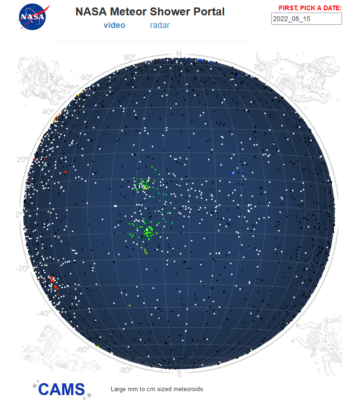
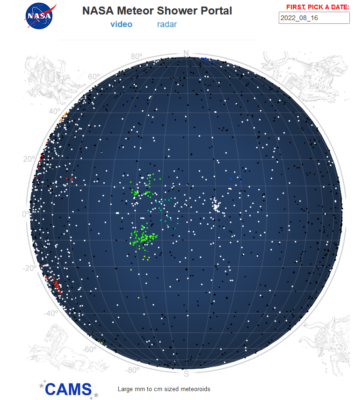
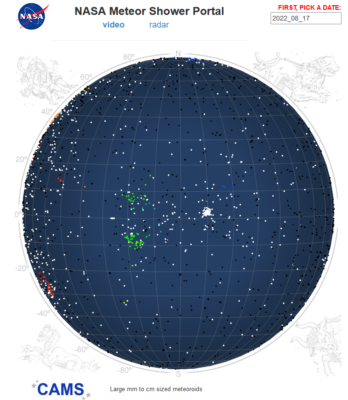
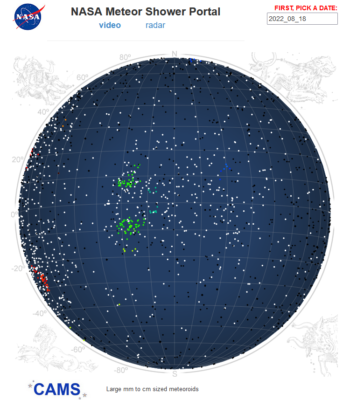

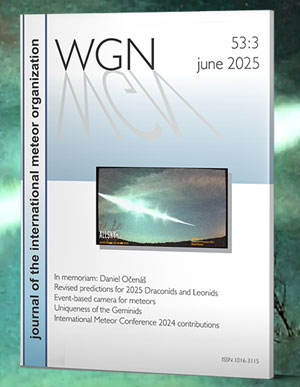
 You saw something bright and fast? Like a huge shooting star? Report it: it may be a fireball.
You saw something bright and fast? Like a huge shooting star? Report it: it may be a fireball.  You counted meteors last night? Share your results with us!
You counted meteors last night? Share your results with us!  You took a photo of a meteor or fireball? You have a screenshot of your cam? Share it with us!
You took a photo of a meteor or fireball? You have a screenshot of your cam? Share it with us!  You caught a meteor or fireball on video? Share your video with us!
You caught a meteor or fireball on video? Share your video with us!
One comment
Witness I believe it’s a fireball
Date 28-08-2022
Time- 11:30pm – 12:45am
Tauranga